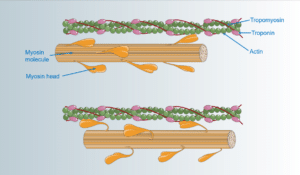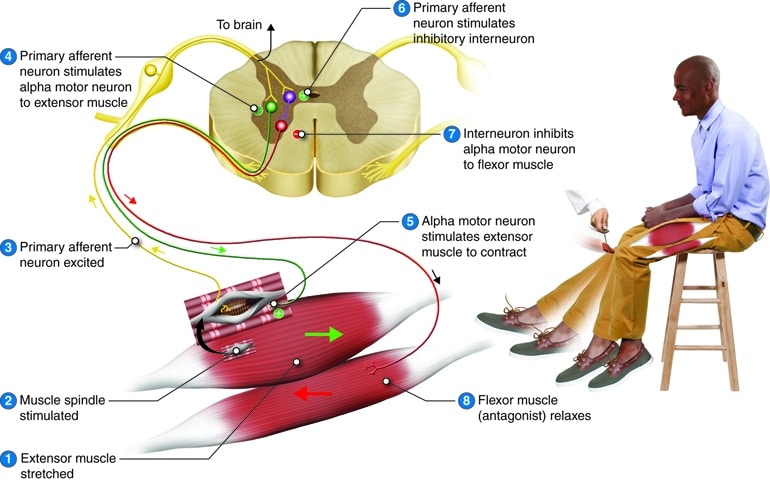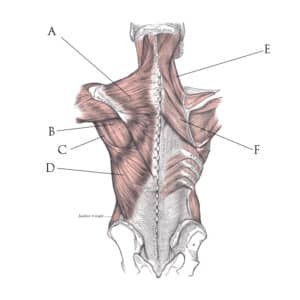Do You Get Knots In Your Neck Muscles?
If you get sore, stiff, or achy muscle knots in your neck, then the tips in this post will help you considerably.
Perhaps you get knots in your neck after working at a computer or spending a lot of time on your tablet or smartphone.
Or maybe you get knots in your neck when you're stressed, like you're carrying the weight of the world on your shoulders.
If any of these apply to you, then watch this video to learn a simple self-massage technique to release knots in your neck muscles.
Physical therapists, massage therapists, and chiropractors often pay hundreds or even thousands of dollars to learn these kinds of techniques. But but all YOU have to do is click the play button below.

What Causes Knots In Neck Muscles?
Before you can learn how to get rid of knots in neck muscles, you first have to understand what causes muscle knots in the first place.
The medical term for muscle knots is trigger points.
Inside your muscles, you have little overlapping filaments called actin and myosin.
These filaments work like rachets to make your muscle contract.
However, sometimes the actin and myosin fibers can get bound together and become unable to release.
That in turn can form a "muscle knot" or trigger point.
Myofacial Release For Knots In Neck Muscles
Therefore, the goal of the myofascial release massage techniques shown here is to release those knots or those adhesions inside trigger points.
Different Approaches To Treating Knots In Neck Muscles
Many people try to release knots in neck muscles with either massage guns, trigger point balls, or other various devices.
Often people use these devices to pulverize their knots in their neck muscles until they're sore.
And that does sometimes feel good.
It's the "hurts but, but feels good" kind of pain.
When you apply this kind of pressure but your brain knows it's not harmful, your brain releases opioids into your blood.
This makes you feel good for a short period, and it feels really good when you stop.
But it doesn't necessarily fix or release the knots in your neck .
So then, how do you get rid of the knots in your neck muscles?
Two Types Of Muscle Receptors
There are two different types of receptors in your muscles that regulate the tone or the tension in a muscle.
Muscle Spindle
One of them is called the muscle spindle, which responds to changes in muscle length.
Attribution: Cenveo, Licensed under Creative Commons 3.0
If you think about when you go to the doctor and they hit your knee with the hammer, that quickly stretches the tendon in your quadricep muscle. As a result is you get that knee-jerk reflex.
So when you activate the muscle spindle, it makes your muscle tighten or tense up.
So, you DON'T want to activate the muscle spindle when you're trying to release a muscle knot.
Golgi Tendon Organ
Contrarily, you have another receptor called the Golgi tendon organ, which responds to is tension.
When a muscle is under tension or it has pressure applied to it, the Golgi tendon organ inhibits the muscle, and makes it relax in order to prevent injury to that muscle.
With this technique, we cant to activate the Golgi tendon organ (GTO) without causing pain or activating the muscle spindle. Both of these would result in a protective muscle contraction.
How To Locate Muscle Knots In Neck
To locate muscle knots in your neck, strum with your fingers perpendicular to the muscle fibers.
The video above shows how to treat the upper trapezius (A) and the levator scapula (E) muscles.
You can see the muscle fiber direction for each of those muscles in the image above.
To locate the muscle knots, use your index and middle finger and thumb to pinch or roll across the muscle fibers.
Explore along the entire length of the muscles and find areas where you feel knots in your neck muscles. These places will likely also be tender to touch.
Once you've found a knot, try to localize further so that you find the most tender, most knotted part of the muscle.
That's likely the epicenter of your trigger point.
Once you've found the trigger point, hold a GENTLE pressure on the area for 90 seconds or longer.
They key is being gentle and being patient.
You're trying to neurologically relax the knots in your neck muscles by activating the Golgi tendon organ.
You're NOT trying to mechanically break up the knots. So keep your pressure light.
In fact, if you press too hard to the point of pain, your brain may try to tighten the muscle up in a fight-or-flight response.
So use finesse, not force, when trying to release knots in your neck.
Once you've gotten one of the knots to release, then move to the next on and the next one, etc.
Treating The Root Cause Of Knots In Your Neck Muscles
Once you've released the knots in your neck muscles, you'll likely feel better for awhile,
But if you don't fix the thing that caused those knots to occur in the first place, they'll eventually come back.
Often the root cause of muscle knots in the neck has to do with repeated or sustained postures.
Examples of such postural causes include:
- Sitting with a forward head at a desk.
- Not using your armrests when you're working at a computer
- Looking down at your tablet or smartphone for too long
- Always carrying a purse over the same shoulder or a bag or a briefcase in the same hand
Over time, asymmetrical postures can push the shoulder down on one side and lengthen your neck muscles.
Stretching isn't always good for knots in your neck
Often people will try to stretch knotted or stiff muscles, and sometimes that's a good solution.
But you can also develop knots or sore muscles from the muscle being posturally lengthened.
When I treat patients clinically with myofascial release-type techniques, I notice that they have knots usually on both sides. Often though, the knots are larger on one side.
However, the side that is more tender or more sore is often NOT the same side that feels tighter and stiffer.
It's much more common for a muscle to become sore because it's been overstretched rather than tight.
It's not always that way, though.
Sometimes the tight muscle is the sore one.
But it's more common for the overstretched neck muscle to be the one that's more sore.
So, you DON'T want to stretch it in that case.
An easy way to tell is to look in the mirror and see if one shoulder is lower than the other.
If that shoulder is your painful shoulder, then you don't want to stretch the painful side.
It's actually more helpful to reach your arms up in the air and stretch up towards the ceiling so that you shorten that overstretched neck muscle.
Or, bring the overstretched arm up in the air and reach it up in the air to stretch the muscles below the shoulder blade.
So again, you don't necessarily always need to stretch a muscle that is sore. Sometimes stretching it will make it worse.
Sometimes stretching CAN help knots in neck muscles
Now, if the sore side is the shoulder that is higher up, then stretch away.
You can do this by tipping your head away from the sore side and holding that gentle stretch for about 60 seconds.
Conclusion
So those were some tips to help you release knots in your neck muscles, plus a few tips to help you understand the root causes of the knots.
Ultimately though, if you are having persistent neck pain, it's a good idea to get it addressed in person by a healthcare professional.
If you live in the St. Louis area and need help for neck pain, we'd be happy to help you here at More for Life. Just tap the button below to request an appointment with one of our specialists.
Like this post? Here are some others you may enjoy:
Have A Knot In The Shoulder Blade That Won't Go Away?
8 Neck Pain Exercises To Help You Get Relief At Home
Chair Yoga Seniors Can Do For Neck Pain and Back Pain In 7 Easy Poses











